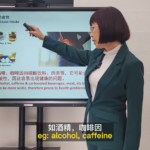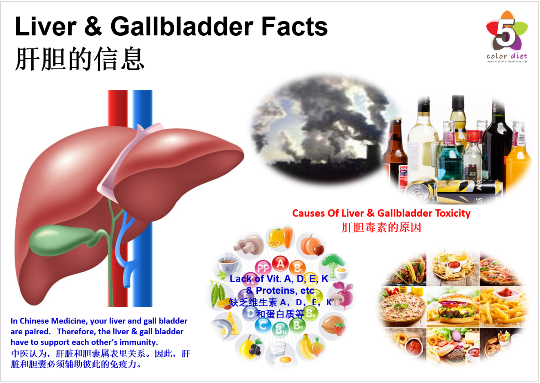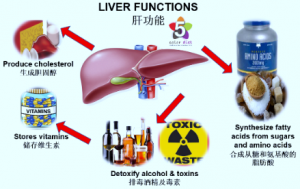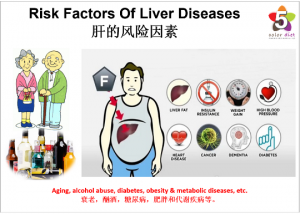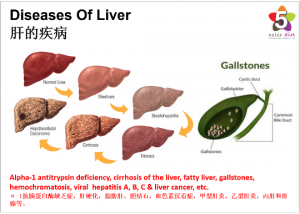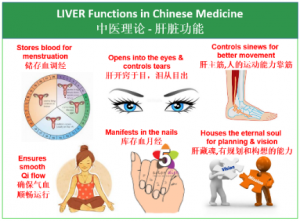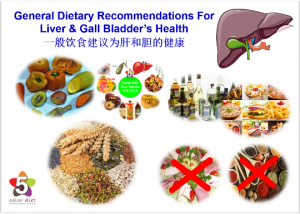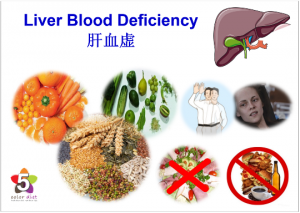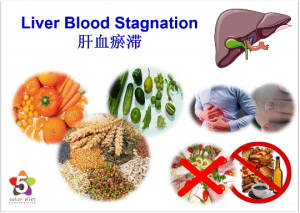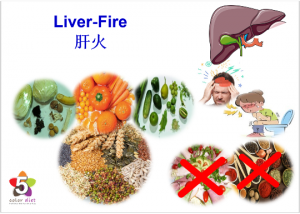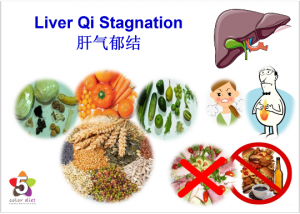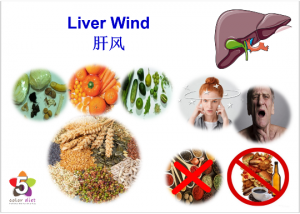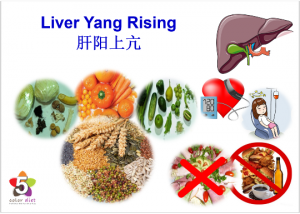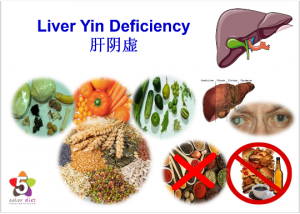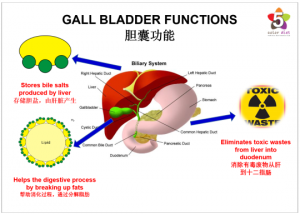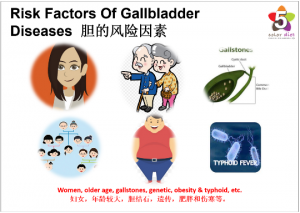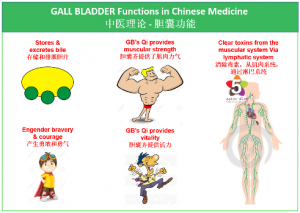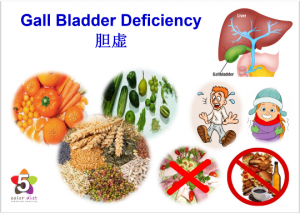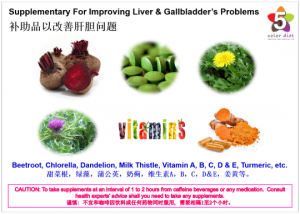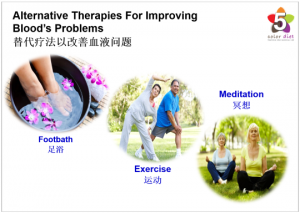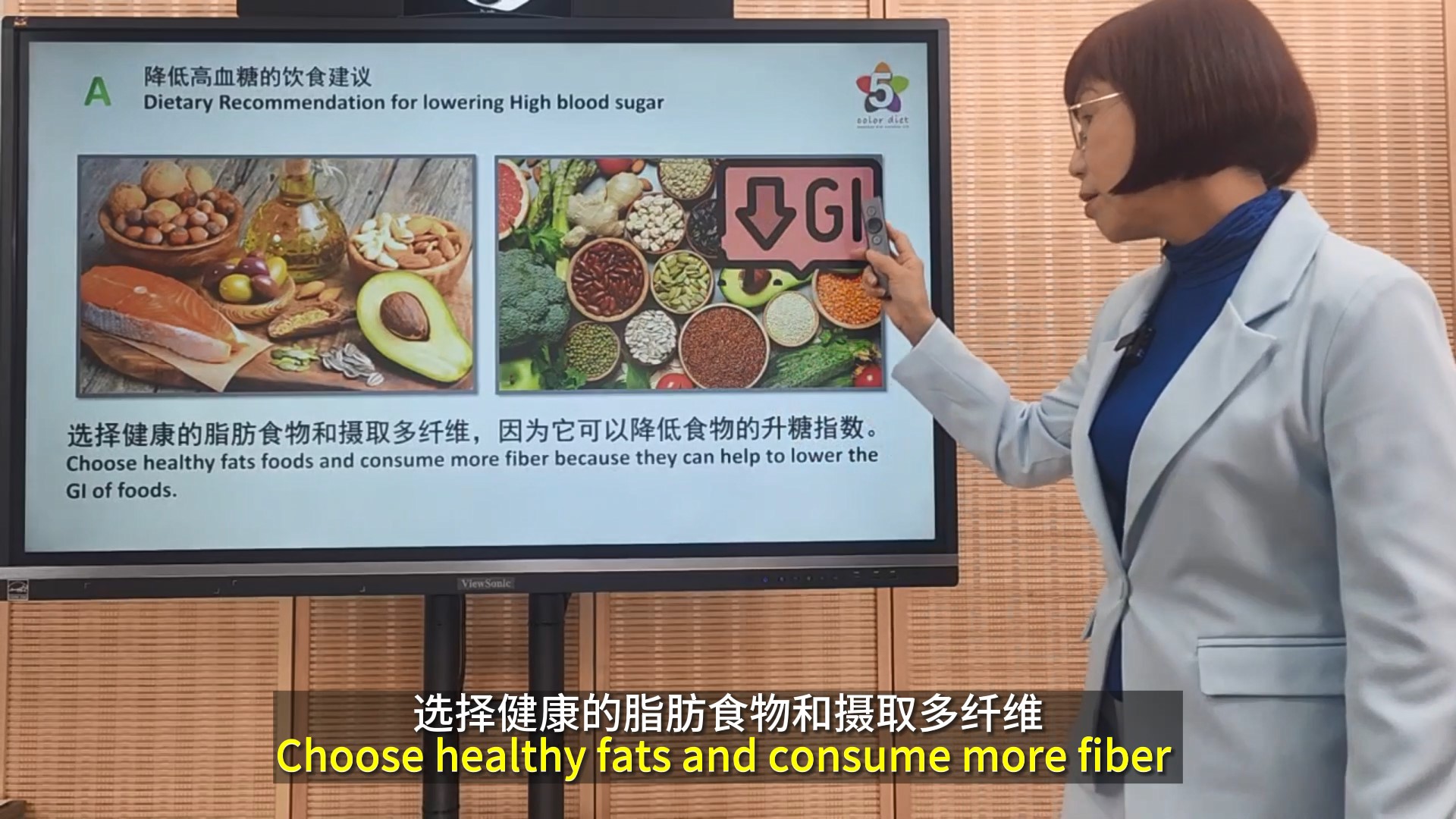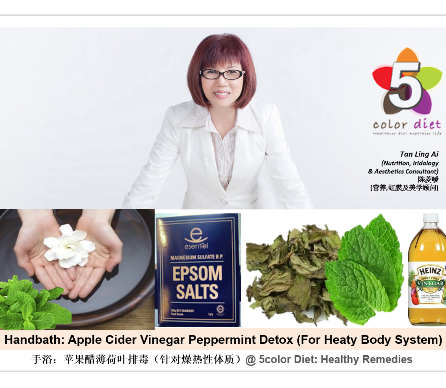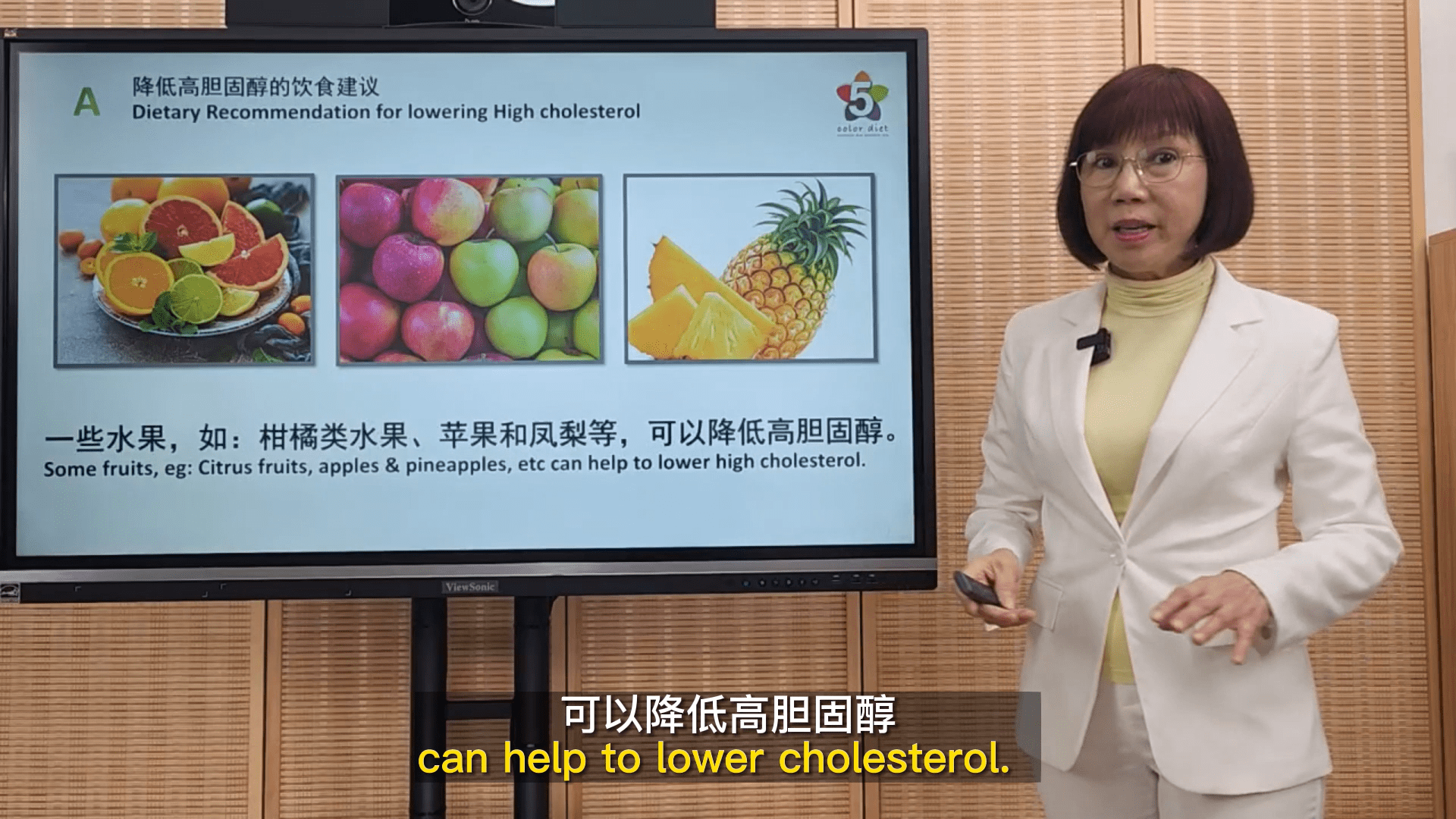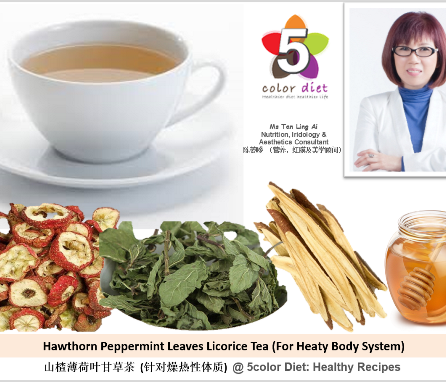
Liver’s Facts
Our liver is the primary organ of detoxification which filters drugs, nutrients and toxins from the body, produces bile to help digest fats, and removes toxic bilirubin from the blood. An unhealthy diet and poor lifestyle can overwork and overload the liver, leaving it unable to process toxins and fat efficiently and may cause liver problems like fatty liver, hepatitis, etc. It can raise the risk of obesity, cardiovascular disease, chronic fatigue, headaches, digestive problems, allergies and many other health problems.
In Western medicine, the liver is considered a gland, and performs a large number of vital tasks including storing vitamins, producing cholesterol, & synthesizing fatty acids from sugars and amino acids. As a detoxifying organ, the liver dilutes toxic substances such as metabolic waste, pesticides, and alcohol, with less toxic substances before sending them to be excreted from the kidneys.
Risk Factors For Liver Diseases
● Age: In the United States, the average age at onset of liver cancer is 63 years. Men are more likely to develop liver cancer than women, by a ratio of 2 to 1.
● Aflatoxins: These are cancer-causing substances made by a fungus that contaminates wheat, corn, soybeans, rice, and some types of nuts. Contamination usually occurs due to storage of the food stuff in a moist, warm environment, more common in warmer and tropical countries. Long-term exposure to aflatoxins is a major liver cancer risk factor, especially in people with Hepatitis B virus (HBV) or Hepatitis C virus (HCV) infections.
● Alcohol Abuse: Alcohol abuse is a common cause of cirrhosis of the liver, which increases a person’s liver cancer risks.
● Anabolic steroids: Used by athletes to increase strength and muscle mass, the long-term use of anabolic steroids (male hormones) might slightly increase the risk of developing liver cancer. Cortisone-like steroids such as hydrocortisone, dexamethasone, and prednisone do not carry the same risk.
● Arsenic: Chronic exposure to naturally occurring arsenic through drinking water (contaminations in some wells) increases the risk of developing some forms of liver cancer.
● Cirrhosis Of The Liver: Cirrhosis occurs when liver cells become damaged and are replaced by scar tissue. People with Cirrhosis have an increased risk of liver cancer. In most cases (up to 90% of the cases in the United States.), people who develop Hepatocellular carcinoma (HCC) have underlying Cirrhosis. There are several possible causes of Cirrhosis. Besides alcohol abuse and chronic Hepatitis B virus (HBV) or Hepatitis C virus (HCV) infections, non-alcoholic steatohepatitis (NASH, a fatty liver disease often seen in obese people who consume little or no alcohol), certain types of inherited metabolic diseases, and autoimmune diseases can cause Cirrhosis.
● Diabetes: Having diabetes can also increase the risk of developing liver cancer.
● Exposure To Certain Chemicals: Exposure to vinyl chloride (a chemical used in the making of some plastics) and thorium dioxide (a chemical previously used for x-ray testing) can increase the risk of developing angiosarcoma of the liver.
● Metabolic diseases: Certain types of inherited metabolic diseases can cause cirrhosis and increase the chances of developing liver cancer. Genetic hemochromatosis (an iron-overload disorder that builds up iron stores throughout the body including the liver), tyrosinemia (elevated levels of the amino acid tyrosine), alpha-1-antitrypsin deficiency, porphyria cutanea tarda (deficiency in heme synthesis), glycogen storage disease, and Wilson disease (elevated levels of copper in the liver) are rare diseases that can damage the liver and increase a person’s liver cancer risks.
● Obesity: Being obese can increase the chances of developing liver cancer, probably through development of Non-Alcoholic Steatohepatitis (NASH) and eventually, cirrhosis.
● Race & Ethnicity: In the United States, liver cancer rates are highest in Asian Americans and Pacific Islanders. White Americans have the lowest risk for liver cancer. Chronic infection with Hepatitis B virus (HBV) or Hepatitis C virus (HCV) is the most common liver cancer risk factor. These infections lead to cirrhosis of the liver. Both hepatitis B and C viruses can spread from person to person through sharing of contaminated needles (such as in drug use), unprotected sex, or childbirth. They can also be passed on through blood transfusion.
Most Common Types Of Liver Diseases
● Alagille syndrome.
● Alpha-1 anti-trypsin deficiency.
● Autoimmune hepatitis.
● Biliary atresia.
● Cirrhosis.
● Cystic disease of the liver.
● Fatty liver disease.
● Galactosemia.
● Gallstones.
● Gilbert’s syndrome.
● Hemochromatosis.
● Liver cancer.
● Liver disease in pregnancy.
● Neonatal hepatitis.
● Primary biliary cirrhosis.
● Primary sclerosing cholangitis.
● Porphyria.
● Reye’s syndrome.
● Sarcoidosis.
● Toxic hepatitis.
● Type 1 glycogen storage disease.
● Tyrosinemia.
● Viral hepatitis A, B, C.
● Wilson disease, etc.
Statistics Of Liver Diseases In United Kingdom in 2004
According to National statistics in the UK, liver diseases have been ranked as the fifth most common cause of death in 2004.
-
Chinese Medicine Theory On Liver Facts
In Chinese Medicine, the liver stores blood, governs and regulates the blood, organizes the “free flow” of Qi energy to promote circulation which cultivates our emotions, soothes digestion, regulates menstruation and bile secretion. The liver is connected with the tendons, nails, and eyes as well. The liver changes harmful toxins into substances, which can be eliminated safely by the colon or kidneys. The liver is our master cleansing organ and the gall bladder is its mate.
Detoxification through taking the right food sources & herbs is one way to help eliminate toxic substances from our Liver & Gall Bladder naturally & improve Liver & Gall Bladder’s health. The detoxification systems of our body need to be in priority order because each organ need to cleanse its toxins or the toxins will spread to other organs. Advisable to follow the detoxification system’s in priority order…
In Chinese medicine, liver imbalances are associated with a variety of causes:
(1) Liver Blood Deficiency
(2) Liver Blood Stagnation
(3) Liver Channel Cold Stagnation
(4) Liver Fire
(5) Liver & Gall Bladder Damp Heat
(6) Liver Qi Stagnation
(7) Liver Wind
(8) Liver Yang Rising
(9) Liver Yin Deficiency
-
General Dietary Recommendations For Liver & Gall Bladder’s Health
Choosing the right diet is one way to better liver & gall bladder’s health.
Pattern Description Causes Of Liver & Gall Bladder Toxicity Alcohol, genetic (Hemochromatosis & Alpha-1 anti-trysin deficiency), greasy foods, heavy metals, medications, obesity, metabolic syndrome (eg: Diabetes, high blood pressure & high cholesterol, etc), nutritional deficiencies (Eg: Vitamin A, D, E, K & proteins, etc), smoking, stress, parasites & viruses, etc. Symptoms Of Liver & Gall Bladder Toxicity Abdominal pain, anger, constipation, dark urine color, depression, diarrhea, dizziness, fatigue, headaches, indigestion, insomnia, jaundice, joint pain, menstruation problems, muscles spasms, nausea, poor vision, vertigo & vomiting, etc. Related Health Problems Of Liver & Gall Bladder Toxicity Allergies, anemia, eye problems (eg: Cataracts, glaucoma & poor vision, etc) , gall bladder problems (Eg: Gallstones, porcelain gall bladder, gall bladder polyps & gall bladder cancer, etc), hepatitis, high blood pressure, high cholesterol, menstrual disorders, neurasthenia, obesity, sleeping problems, stress & weak joints or weak muscles, etc. Recommended Food Sources For Improving Liver & Gall Bladder Health ● In Traditional Chinese Medicine’s theory, consuming Green Fruits & Vegetables will help liver health eg: Artichokes, asparagus, avocados, broccoli, Brussels sprouts, celery, Chinese cabbage, chives, cucumbers, green apples, green beans, green cabbage, green grapes, green onions, green pears, green peppers, honeydew melon, kale, kiwifruit, leafy greens, leeks, lettuce, lima beans, limes, ladyfinger, parsley, peas, spinach, sprouts, watercress, zucchini, etc. ● In Traditional Chinese Medicine’s theory, consume Orange & Yellow fruits & vegetables will help in spleen-stomach & liver health eg: Apricots, cantaloupe (western honeydew), carrots, grapefruit, golden kiwifruit, lemons, mandarin oranges, mangoes, nectarines, oranges, orange peppers, papayas, peaches, persimmons, pineapples, pumpkin, sweet corn, sweet potatoes, tangerines, yellow apples, yellow beets, yellow pears, yellow potatoes, yellow tomatoes, yellow watermelon, yellow winter squash, etc.
● In addition, take food sources with Sour Flavour as well. (Eg: apple cider vinegar, lemon, hawthorn fruit, loquat fruit, pineapples, plums, pomelo & vinegar, etc).
● Food diet should comprise of Proteins only 10-20%, Complex carbohydrates 20-30% like grains and starchy root vegetables & Cooked vegetables 50% & more.
Foods To Avoid Or Least Intake For Improving Liver & Gall Bladder Health ● Alcoholic beverages, caffeine beverages, cold & raw foods (Eg: iced drinks, raw meat, salads or white/ tan & brown fruits & vegetables), fried or greasy foods, offal, processed foods, salt, sour or spicy foods & sugar, etc. ● Those with cold body system should take more dark green color fruits and vegetables because these foods have warm energy which will help to increase your energy level.
● Excessive intake of orange or yellow fruits and vegetables may cause yellow skin.
● Moderate intake of foods with Sour flavor for those who have water retention because foods with Sour flavor may cause water retention.
● Avoid smoking & stress.
-
Dietary Recommendations For Liver Blood Deficiency
The Liver stores Blood, so deficiency of Blood can easily affect Liver. The Liver also opens to eyes, so when Liver Blood is deficient, the eyes may lack nourishment and be unable to see clearly. The Liver also affects muscular tension. When deficient Liver Blood cannot nourish the tendons, symptoms such as muscular weakness, cramping, and hypertonicity of tendons appear. Liver manifests in nails, and when the nails are not nourished by Liver Blood, they become brittle.
Pattern Description Causes Of Liver Blood Deficiency ● Caused by general Blood Deficiency include blood loss due to trauma, surgery,menstrual hemorrhaging, a diminished blood production or chronic nutritional deficiencies. ● In women, Liver Blood deficiency is related with Liver Qi stagnation. When Liver Qi stagnation interferes with the Spleen energy, the process of transforming food into proper nutrition for your body, and then transporting that nutrition to where it is needed, is weakened, leading to even more Liver Blood deficiency.
● Kidney Qi or Kidney Jing deficiency can lead to deficient Liver Blood because Kidneys play an important role in production of Blood and Qi.
● Liver Blood deficiency syndrome is related to Liver Yin deficiency such as Parkinson’s disease.
● Liver Blood is a sub-category of Blood, formed by Stomach, Spleen, Lungs, Ming Men & Heart. If any of these organs energies is deficient, it will affect your Liver Blood. If food eaten is deficient in poor nutrition, this will affect Liver Blood.
● Not enough protein in the diet or an irregular/poor diet can weaken Spleen. The Spleen then, does not produce Blood, which leads to Liver not having enough Blood to store & the Liver cannot nourish the tendons and the eyes.
Symptoms Of Liver Blood Deficiency Eye problems: blurred vision, dry eyes, “floaters” in the eyes or color blindness; face: dull, pale & pale lips; limbs: numbness; menstruation: scanty & painful or amenorrhea; muscles: cramps, spasms & weakness; nails: brittle, pale & withered. Tongue: pale on both sides. In severe cases, the sides may be orange color.
Related Health Problems Of Liver Blood Deficiency Anemia, eye problems: cataracts & night blindness, high blood pressure, malnutrition, menstrual disorders & neurasthenia, etc. Recommended Food Sources For Improving Body Imbalance Related To Liver Blood Deficiency ● Beans: Almonds, black sesame seeds, black soybeans, cashew nuts, chick peas, Chinese almonds, fava beans, kidney beans, red beans, sesame seeds, sunflower seeds, miso paste & tempeh, etc. ● Fruits: Apple, apricot, avocado, berries, cherries, coconut, dates, figs, goji berries, grapes, longan, lychee, mulberries, stewed fruits and especially dark green/ orange/ yellow/ red/ black/ purple & blue fruits, etc.
● Grains: Cooked whole grains, amaranth, roasted barley, brown rice, buckwheat, Chinese barley, glutinous rice, millet, oats, quinoa & wheat bran.
● Herbs & Spices: Dang Shen, dong quai, garlic, ginseng, ginger, Korean ginseng, onions, parsley, turmeric & wheatgrass, etc.
● Meat & Seafood: Animal livers & kidneys, chicken, mussels, octopus, oysters, red meat, deep-sea fish (Eg: salmon & tuna), etc.
● Vegetables: Alfalfa sprouts, artichoke, beetroot, button mushrooms, carrot, corn, dandelion leaf, green peas, kale, leeks, parsnips, pumpkin, shiitake mushrooms, spinach, sweet potatoes, wheatgrass, taro root, yams and especially dark green/ orange/ yellow/ red/ black/ purple & blue vegetables, etc.
● Others: Blackstrap molasses, marmite and Teas (Eg: Dang Shen, Dong Quai, ginger, ginseng, turmeric, lavender flowers & rosebuds), etc.
● Food diet should comprise of Proteins 20-30%, Complex carbohydrates 20-30% like grains and starchy root vegetables & Cooked vegetables 30-40%.
Foods To Avoid Or Least Intake For Improving Body Imbalance Related To Liver Blood Deficiency ● Alcohol, caffeine beverages, carbonated beverages, chocolates, cold & raw foods (Eg: iced drinks, raw meat, salads or white/ tan & brown fruits & vegetables), dairy products (Eg: butter, cheese, eggs & milk except yogurt), fried or greasy foods, processed foods & refined sugars (Eg: biscuits, cakes & pastries), etc. ● Excessive of Vitamin C (Not more than 3,000 mg).
● Avoid smoking & stress.
-
Dietary Recommendations For Liver Blood Stagnation
Liver Blood Stagnation will often present with one or more of the following indications: sharp pain on sides and around ribs; headaches with fixed stabbing pain; painful, irregular periods; with purple or brown blood; abdominal masses; enlarged Liver or Spleen. The Liver controls the menstrual Blood; stagnation of the Lower Jiao would be indicated with menstrual Blood that had clots, or is dark in color (brown-purple). Heavy menstrual bleeding and prolonged menstrual cycles can also be indications of Blood Stagnation.
Pattern Description Causes Of Liver Blood Stagnation ● Abortions. ● Heavy blood loss during childbirth
● Intake of too much cold foods like iced drinks, salads or white/ tan & brown fruits & vegetables. Advisable not to take cold foods 1 week before menstruation or during menstruation period.
● Intercourse during menstruation.
● Intra-abdominal surgery.
● Intrauterine device (IUD).
● Long term Liver Qi Stagnation.
● Traumatic injury or surgery.
Symptoms Of Liver Blood Stagnation Abdominal pain, clotted & dark menstrual blood, flanks pain, groin pain, nosebleeds, painful periods, purple color nails & lips & sharp painful masses in abdomen, etc. Tongue: purple color, possibly with purple spots.
Related Health Problems Of Liver Blood Stagnation Enlarged liver or spleen, menstrual disorders, growth & tumours in some organs, etc. Recommended Food Sources For Improving Body Imbalance Related To Liver Blood Stagnation ● Beans, Nuts & Seeds: Almonds, black beans, chestnuts, Chia seeds, Chinese almonds, flaxseeds, gingko nuts, kidney beans, pine nuts, pumpkin seeds, red beans, walnuts, soybeans, miso paste & tempeh, etc. ● Fruits: Apricot, banana, citrus fruits, hawthorn fruit, lemon, mango, papaya, peach, plum, raisins, sour jujube, sugar cane, especially most green/ orange & yellow color fruits, etc.
● Grains: Amaranth, cereals, oats, quinoa & white rice, etc.
● Herbs & Spices: Alfalfa, basil, Burdock, chives, Dang Shen, garlic, ginger, licorice, lotus leaf, onions, nutmeg, parsley, rosemary, sage, shallots, turmeric & white pepper, etc.
● Meat & Seafood: Abalone, clams, crab, fish, jellyfish, lean meat & sea cucumber, etc.
● Vegetables: Asparagus, black fungus, broccoli, Brussels sprouts, carrot, celery, Chinese radish, eggplants, kelp, leeks, mushrooms, pumpkin, seaweed, spinach, taro root, yams, zucchini, especially most green/ orange & yellow color vegetables, etc.
● Others: Brown sugar, healthy oils (eg: canola oil, chia seeds oil, olive oil & safflower oil), vinegar and Teas (Eg: chrysanthemum, green tea, lavender flowers & rosebuds), etc.
● Food diet should comprise of Proteins only 10%, Complex carbohydrates 30% like grains and starchy root vegetables & Cooked vegetables 40-60%.
Foods To Avoid Or Least Intake For Improving Body Imbalance Related To Liver Blood Stagnation ● Alcohol, all nuts & seeds except those stated in Recommended food sources, caffeine beverages, carbonated beverages, chocolate, cold or raw foods (Eg: iced drinks, salads or white/ tan & brown fruits & vegetables), dairy products (Eg: butter, cheese, eggs & milk except yogurt), fried or greasy foods, grains (Eg: brown rice & millet), processed foods, refined sugars (Eg: biscuits, cakes & pastries), red meat, salt, spicy foods & tomatoes, etc. ● Excessive of Vitamin C (Not more than 3,000 mg).
● Avoid smoking & stress.
-
Dietary Recommendations For Liver Channel Cold Stagnation
Caused by invasion of Liver Channel by Cold. Liver channel tranverses external genitals; Cold contracts, causing pain and contraction. Invasion of exterior Cold (aggravated by Stagnation of Liver Qi).
Pattern Description Causes Of Liver Channel Cold Stagnation ● Caused by Cold which can arise from external factors (eg: cold weather & air-conditioned). ● Also caused by Cold which can arise from internal factors (eg: Yang deficiency & cold foods (Eg: iced drinks, salads or white/ tan & brown fruits & vegetables).
● Cold can lead to stagnation of Blood & pain.
Symptoms Of Liver Channel Cold Stagnation Aversion to cold, boring or stabbing pain in lower abdomen, constricting headaches, diarrhea or loose stools, in female: lower abdomen pain in the bladder or vagina, in men: distending, heavy & dragging pain or straining sensation in the groin or testes, thirstless & prefer hot drinks & urine pale color, etc. Tongue: pale & moist with a white coating.
Related Health Problems Of Liver Channel Cold Stagnation Amenorrhea (Absence of Menstruation), cold-type menstrual disorders, hernia & infertility, etc. Recommended Food Sources For Improving Body Imbalance Related To Liver Channel Cold Stagnation ● Beans, Nuts & Seeds: Almonds, beancurd, Chinese almonds, red beans & walnuts, etc. ● Fruits: black dates, cherries, citrus fruits, grapefruits, hawthorn fruit, loquats, red dates, tangerines, tangerine peel, especially most green/ orange & yellow color fruits, etc.
● Grains: Barley, buckwheat, Chinese barley & white rice, etc.
● Herbs & Spices: Basil, caraway seeds, cardamom, cumin, dill, fennel, garlic, ginger, horseradish, mustard seeds, onions, peppers, peppermint leaves & turmeric, etc.
● Meat & Seafood: All fishes.
● Vegetables: Artichokes, asparagus, beets, broccoli, Brussel sprouts, cabbage, carrots, cauliflower, celery, Chinese chives, Chinese radish, lily bulbs, kelp, mustard greens, pickled vegetables, pumpkin, seaweed, sweet potatoes, turnips, watercress, water chestnuts, wheat, yam, zucchini especially most green/ orange & yellow color vegetables, etc.
● Others: Blackstrap molasses, olive oil and Teas (Eg: Chamomile, chrysanthemum, ginger, jasmine flowers, milk thistle, peppermint leaves, rosebuds & saffron), etc.
● Food diet should comprise of Proteins only 10%, Complex carbohydrates 30% like grains and starchy root vegetables & Cooked vegetables 40-60%.
Foods To Avoid Or Least Intake For Improving Body Imbalance Related To Liver Channel Cold Stagnation ● Alcohol, all nuts & seeds except those stated in Recommended food sources, caffeine beverages, carbonated beverages, cheese, chocolate, cold or raw foods (Eg: iced drinks, salads or white/ tan & brown fruits & vegetables), dairy products except yogurt, fried or greasy foods, grains (Eg: brown rice & millet), processed foods, raw vegetables juices, refined sugars (Eg: biscuits, cakes & pastries), red meat, salt, spicy foods & tomatoes, etc. ● Avoid smoking & stress.
-
Dietary Recommendations For Liver Fire
Long-standing state of anger, repressed anger or frustration which causes Qi to stagnate and form Heat. Excessive consumption of alcohol, fried foods, meat also tend to cause Liver Heat. Especially meats such as beef and lamb, which are attributed to hotter energy.
Pattern Description Causes Of Liver Fire ● Alcoholism. ● Greasy & spicy foods.
● Long term Liver Qi Stagnation.
● Smoking.
Symptoms Of Liver Fire Anger, bitter taste in the mouth, constipation, dark urine, headache, insomnia, red eyes & tinnitus, etc. Tongue: red color & yellow coating.
Related Health Problems Of Liver Fire Acute hepatitis, alcoholism, chronic liver imbalances that develop into heat patterns, conjunctivitis, ear infections, gall bladder infections, gallstones, high blood pressure, hyperthyroidism, long term stagnation of Qi due to anger & neurasthenia, etc. Recommended Food Sources For Improving Body Imbalance Related To Liver Fire ● Bean, Nuts & Seeds: Beancurd, green beans, soybean products, miso paste, tempeh & yogurt, etc. ● Fruits: Apples, banana, Chinese pears, kiwi, mangoes, pears, watermelons and especially green/ orange & yellow fruits, etc.
● Grains: Barley, Chinese barley, millet, oats, rice & wheat, etc.
● Herbs & Spices: Mulberry leaves & peppermint leaves.
● Meat & Seafood: Black-boned chicken, clams, crab & oysters, pigeon eggs, etc.
● Vegetables: Asparagus, alfalfa sprouts, arugula, avocado, bamboo shoots, broccoli, cabbage, cauliflower, celery, cucumber, eggplant, kelp, lettuce, purslane, radish, seaweed, spinach, Swiss chard, tomatoes, water chestnut, watercress, zucchini especially green/ orange & yellow vegetables, etc.
● Others: Teas (Eg: Chrysanthemum, green tea, lotus leaf, mulberry leaves & peppermint leaves, etc).
● Food diet should comprise of Proteins only 10%, Complex carbohydrates 30% like grains and starchy root vegetables & Cooked vegetables 40-60%.
Foods To Avoid Or Least Intake For Improving Body Imbalance Related To Liver Fire ● Alcohol, caffeine beverages, carbonated beverages, chocolates, citrus fruits, fried or greasy foods, processed foods, pungent herbs (Eg: basil, capsicum, cinnamon, cloves, garlic, ginger, horseradish, leeks, onions, shallots, etc), red meat, shrimps, spicy foods & vinegar, etc. ● Avoid smoking & stress.
-
Dietary Recommendations For Liver & Gall Bladder Damp Heat
This pattern is a combination of Heat in Liver and Dampness in Spleen. There must be Dampness in Spleen for the pattern to manifest. Dampness in Liver and Gallbladder channel causes Liver Qi to stagnate by obstructing the smooth flow of Liver Qi. This results in distention/pain of hypochondrium and chest. Then the Liver Qi invades Stomach, with symptoms such as (nausea, vomiting, loss of Appetite and abdominal distention. Accumulation of Dampness can obstruct the flow of bile and cause jaundice. Damp-Heat causes low grade continuous fever. Dampness can flow down and settles in Lower Burner and give rise to symptoms such as vaginal discharge and itching or pain/swelling and redness of scrotum.
Spleen Deficiency (irregular eating habits, excessive consumption of Cold and raw foods, protein deficient diet, excessive thinking or mental strain). Liver Qi Stagnation over long time (excessive emotional frustration, repressed anger, etc.) causes Liver Heat, which combines with dampness to obstruct the Liver and Gallbladder. Invasion of exogenous Damp-Heat is common in tropics but less common in temperate climates.
Pattern Description Causes Of Liver & Gall Bladder Damp Heat ● Consuming too much cold or raw foods or drinks. ● Emotional stress.
● Hot & humid weathers.
● Intake of too much alcohol, dairy products, greasy foods, junk foods, spicy foods & meat, etc.
● Take foods too fast or under emotional pressure.
● Take too much medications.
Symptoms Of Liver & Gall Bladder Damp Heat An aversion to greasy food, bitter taste in the mouth, burning diarrhea, dark & yellow color urine, digestive problems, jaundice, lack of appetite, nausea & vomiting, etc. Tongue: red with a thick & greasy yellow coating.
Related Health Problems Of Liver & Gall Bladder Damp Heat Acute hepatitis, eczema, gall bladder infections, gallstones, herpes, high cholesterol, Raynaud’s Disease, testicular pain & vaginal discharge, etc. Recommended Food Sources For Improving Body Imbalance Related To Liver & Gall Bladder Damp Heat ● Beans, Nuts & Seeds: Adzuki beans, almonds, beancurd, bean sprouts, Chinese almonds, green beans, hyacinth beans, lotus seeds, soybeans, miso paste & tempeh, etc. ● Fruits: Banana, cranberries, lemon, loquat, persimmons, watermelon, especially most green/ orange & yellow color fruits, etc.
● Grains: Amaranth, barley, Chinese barley, millet, rice, rye & whole wheat, etc.
● Herbs & Spices: Mulberry leaves & peppermint leaves.
● Meat & Seafood: duck & all fishes.
● Vegetables: Alfalfa sprouts, amaranth leaves, arugula, asparagus, bamboo shoots, bittergourd, bok choy, broccoli, cabbage, cauliflower, carrots, Chinese cabbage, celery, cucumber, eggplants, kelp, lettuce, lotus root, mushrooms, peas, purslane, radish, spinach, Swiss chard, tomatoes, water chestnuts, watercress, wax gourd, wild rice stems, zucchini especially most green/ orange & yellow color vegetables, etc.
● Others: Coconut oil, flaxseed oil, olive oil and Teas (Eg: Chinese barley, chrysanthemum, chrysanthemum leaves, green tea, mulberry leaves & peppermint leaves), etc.
● Food diet should comprise of Proteins only 20%, Complex carbohydrates 20-30% like grains and starchy root vegetables & Cooked vegetables 50%.
Foods To Avoid Or Least Intake For Improving Body Imbalance Related To Liver & Gall Bladder Damp Heat ● Alcohol, carbonated beverages, caffeine beverages, cold & raw foods (Eg: iced drinks, raw meat, salads or white/ tan & brown fruits & vegetables), dairy products (Eg: butter, cheese, eggs & milk except yogurt), fried or greasy foods, processed foods, pungent herbs (Eg: basil, capsicum, chili, cinnamon, cloves, garlic, ginger, horseradish, leeks, onions, shallots, turmeric), red meat, refined sugars (Eg: biscuits, cakes & pastries), salt, shrimps, spicy foods, etc. ● Do not take foods too fast or too many medications.
● Avoid smoking & stress.
-
Dietary Recommendations For Liver Qi Stagnation
This is an extremely common pattern. Wide range of symptoms, which typically fluctuate considerably in proportion to the amount of stress the person feels. The person will have periods of depression with worsening of physical symptoms, and times when symptoms improve. Women during the premenstrual time are naturally more prone to stagnation-related problems, since at this time Blood is collecting in the uterus and Qi levels are diminishing. Stagnation of Liver Qi over a long time induces stasis of Liver Blood. Emotional disharmony, especially repressed anger, resentment, frustration, over a long time, which impairs the circulation of Liver Qi.
Pattern Description Causes Of Liver Qi Stagnation ● Depression. ● Environmental toxins eg: polluted air, heavy metals, etc,
● Hot & spicy foods.
● Poor sleeping patterns.
● Stress.
● Sedentary.
Symptoms Of Liver Qi Stagnation Abdominal distention, anger, anxiety, depression, fullness in the chest, frustration, indigestion, irritability, premenstrual syndrome, sigh often & tenderness around ribs, etc. Tongue: normal or red tip & thin white coating.
Related Health Problems Of Liver Qi Stagnation Amenorrhea (Absence of Menstruation), chronic fatigue, depression, female infertility, gallstones, gastroenteritis, hepatitis, high cholesterol, liver cancer, menstrual problems, neurosis, Pneumothorax, Raynaud’s Disease & stress, etc. Recommended Food Sources For Improving Body Imbalance Related To Liver Qi Stagnation ● Beans, Nuts & Seeds: Almonds, beancurd, Chinese almonds, red beans & walnuts, etc. ● Fruits: Black dates, cherries, citrus fruits, grapefruits, hawthorn fruit, loquats, red dates, tangerines, tangerine peel, especially most green/ orange& yellow color fruits, etc.
● Grains: Barley, buckwheat, Chinese barley & white rice, etc.
● Herbs & Spices: Basil, caraway seeds, cardamom, cumin, dill, fennel, garlic, ginger, horseradish, mustard seeds, onions, peppers, peppermint leaves & turmeric, etc.
● Meat & Seafood: All fishes.
● Vegetables: Artichokes, asparagus, beets, broccoli, Brussel sprouts, cabbage, carrots, cauliflower, celery, Chinese chives, Chinese radish, lily bulbs, kelp, mustard greens, pickled vegetables, pumpkin, seaweed, sweet potatoes, turnips, watercress, water chestnuts, wheat, yam, zucchini, especially most green/ orange & yellow color vegetables, etc.
● Others: Blackstrap molasses, olive oil and Teas (Eg: Chamomile, chrysanthemum, ginger, jasmine flowers, milk thistle, mulberry leaves, peppermint leaves, rosebuds & saffron), etc.
● Food diet should comprise of Proteins only 10%, Complex carbohydrates 30% like grains and starchy root vegetables & Cooked vegetables 40-60%.
Foods To Avoid Or Least Intake For Improving Body Imbalance Related To Liver Qi Stagnation ● Alcohol, all nuts & seeds except those stated in Recommended food sources, caffeine beverages, carbonated beverages, cheese, chocolate, cold or raw foods (Eg: iced drinks, salads or white/ tan & brown fruits & vegetables), dairy products (Eg: butter, cheese, eggs & milk except yogurt), fried or greasy foods, grains (Eg: Brown rice & millet), processed foods, raw vegetables juices, refined sugars (Eg: biscuits, cakes & pastries), red meat, salt, spicy foods & tomatoes, etc. ● Avoid smoking & stress.
-
Dietary Recommendations For Liver Wind
Liver Wind, also referred as Liver Wind stirring internally, is internal Wind arising from extreme Yin/ Yang and Qi/ Blood imbalance when excessive depletion of Liver and kidney Yin humor deprives the Liver’s Yang Qi of its nourishment and counter-balancing. The result of this is an erratic movement of Liver-Qi manifesting sings characterized by movement or by the absence of it, like for example tremor and convulsions or paralysis.
Pattern Description Causes Of Liver Wind ● Caused by heat which can arise from external factors (eg: hot weather & hot working environment like construction sites & kitchen), etc. ● Long term Liver Yin Deficiency.
Symptoms Of Liver Wind Convulsions, difficulty in speaking, dizziness, headache, muscle spasms, neck stiffness, rigidity, shaking, tics & vertigo, etc. Tongue: deep-red color with thick yellow coating.
Related Health Problems Of Liver Wind High blood pressure, osteoarthritis, Parkinson’s disease & seizures with high fever, stress, stroke, tetanus & vertigo, etc. Recommended Food Sources For Improving Body Imbalance Related To Liver Wind ● Beans, Nuts & Seeds: Beancurd, Chinese almonds, green beans, lotus seeds, red beans, soybeans, miso paste & tempeh, etc. ● Fruits: Chinese pears, cranberries, goji berries, lemons, olives, persimmons, watermelons and especially most green/ orange/ yellow/ white/ tan & brown fruits, etc.
● Grains: Barley, Chinese barley, millet, white rice, rye & whole wheat, etc.
● Herbs & Spices: Dang Shen, green tea, lotus leaf, mulberry leaves, peppermint leaves, tangerine peel, etc.
● Meat, Poultry & Seafood: Chicken & fish.
● Vegetables: Alfalfa sprouts, amaranth leaves, arugula, asparagus, bamboo shoots, broccoli, cabbage, cauliflower, Chinese cabbage, carrots, celery, Chinese spinach, eggplants, kelp, kudzu root, lettuce, lily bulb, lotus root, peas, mushrooms, purslane, radish, spinach, Swiss chard, tomatoes, watercress, white fungus, especially most green/ orange/ yellow/ white/ tan & brown vegetables, etc.
● Others: Teas (Eg: Chinese barley, chrysanthemum, chrysanthemum leaves, green tea, honeysuckle flowers, mulberry leaves, peppermint leaves & tangerine peel), etc.
● Food diet should comprise of Proteins only 10%, Complex carbohydrates 30% like grains and starchy root vegetables & Cooked vegetables 40-60%.
Foods To Avoid Or Least Intake For Improving Body Imbalance Related To Liver Wind ● Alcohol, caffeine beverages, carbonated beverages, cheese, chocolates, citrus fruits, dairy products (Eg: butter, cheese, eggs, milk except yogurt), fried or greasy foods, peanuts, pickles, processed foods, pungent herbs (Eg: basil, capsicum, chilli, cinnamon, cloves, garlic, ginger, horseradish, leeks, onions, shallots), red meat, salt, shrimps, spicy foods & vinegar, etc. ● Avoid smoking & stress.
-
Dietary Recommendations For Liver Yang Rising
This both an excess and deficient pattern. The excess being the Rising Liver Yang and heat, the deficiency usually being that of Liver Yin or Kidney Yin. In Five Element theory, it means that water fails to nourish wood. Difference between Liver Fire Blazing Upwards and Liver Yang Rising: Liver Fire Blazing is a true Excess pattern where it produces Excess Fire that dries up Body Fluids and causes signs of Dryness, such as constipation, red eyes, scanty and dark urine, bitter taste, etc. While Liver Yang Rising does not have full Heat signs because the excess is due to deficiency.
Pattern Description Causes Of Liver Yang Rising ● Emotional stress. Refer to Liver Qi Stagnation. ● Liver Blood Deficiency.
● Liver Channel Cold Stagnation.
● Liver Yin Deficiency.
● Weak digestion, insufficient nutrition or poor eating habits.
Symptoms Of Liver Yang Rising Anger, dry mouth & throat, dizziness, headaches, heaty, insomnia, irritability, stress, sudden deafness & tinnitus, etc. Tongue: Red with redder sides. If due to Liver Blood Deficiency, the tongue is pale. If due to severe Liver and Kidney Yin Deficiency, the tongue is red and peeled.
Related Health Problems Of Liver Yang Rising Anemia, blood pressure diseases, chronic hepatitis, eye problems, high blood pressure, menstrual disorders, menopause, neurasthenia & stroke, etc. Recommended Food Sources For Improving Body Imbalance Related To Liver Yang Rising ● Beans, Nuts & Seeds: Almonds, beancurd, Chinese almonds, red beans & walnuts, etc. ● Fruits: black dates, cherries, citrus fruits, grapefruits, hawthorn fruit, loquats, peppermint leaves (to remove), red dates, tangerines, tangerine peel, especially most green/ orange & yellow color fruits, etc.
● Grains: Barley, buckwheat, Chinese barley & white rice, etc.
● Herbs & Spices: Basil, caraway seeds, cardamom, cumin, dill, fennel, garlic, ginger, horseradish, mustard seeds, onions, peppers, peppermint leaves & turmeric, etc.
● Meat & Seafood: All fishes.
● Vegetables: Artichokes, asparagus, beets, broccoli, Brussel sprouts, cabbage, carrots, cauliflower, celery, Chinese chives, Chinese radish, lily bulbs, kelp, mustard greens, pickled vegetables, pumpkin, seaweed, sweet potatoes, turnips, watercress, water chestnuts, wheat, yam, zucchini especially most green/ orange & yellow color vegetables, etc.
● Others: Blackstrap molasses, olive oil and Teas (Eg: Chamomile, chrysanthemum, ginger, jasmine flowers, milk thistle, peppermint leaves, rosebuds & saffron), etc.
● Food diet should comprise of Proteins only 10%, Complex carbohydrates 30% like grains and starchy root vegetables & Cooked vegetables 40-60%.
Foods To Avoid Or Least Intake For Improving Body Imbalance Related To Liver Yang Rising ● Alcohol, all nuts & seeds except those stated in Recommended food sources, caffeine beverages, carbonated beverages, cheese, chocolate, cold or raw foods (Eg: iced drinks, salads or white/ tan & brown fruits & vegetables), dairy products except yogurt, fried or greasy foods, grains (Eg: brown rice & millet), processed foods, raw vegetables juices, refined sugars (Eg: biscuits, cakes & pastries), red meat, salt, spicy foods & tomatoes, etc. ● Avoid smoking & stress.
-
Dietary Recommendations For Liver Yin Deficiency
The syndrome of Liver Yin Deficiency is often observed in chronic diseases, people over 50 years old or people with a constitution of Yin Deficiency. When the Liver Yin is too weak to nourish its orifice and support the head, the Qi movement and the blood circulation, symptoms like dizziness, headache, blurred vision and a dry and tired sensation of the eyes may present. If the Liver Yin is too weak to nourish the tendons, the joints become stiff and the knees will become weak. The Liver Yin Deficiency often follows Liver Blood Deficiency. In conditions where Yin and blood are both deficient, they are unable to house the soul, to spread the Qi and to regulate the blood, dream-disturbed sleep, depression, irregular menstruation and tiredness may arise.
Pattern Description Causes Of Liver Yin Deficiency ● Emotional problems like grieving or sadness. ● Excessive exercise or physical exertion.
● Frequent high fevers.
● In women, childbirth can be the cause especially if you had too many pregnancies.
● Kidney Jing & Yin deficiencies.
● Long-term Liver Blood deficiency eg: from heavy menses.
Symptoms Of Liver Yin Deficiency Agitated, blurred or impaired vision, constipation with dry stools, depression, dry eyes, dry skin, fatigue, heat sensations in palms & soles, lower abdomen pain, insomnia, night blindness, night sweats, restlessness, pain in the groin and testicular pain, etc. Tongue: red color with little or no coating (if any coating, it is white color or sometimes a little yellow color).
Related Health Problems Of Liver Yin Deficiency Cataracts, hepatitis, high cholesterol, high blood pressure, liver cancer, neurasthenia & night blindness, etc. Recommended Food Sources For Improving Body Imbalance Related To Liver Yin Deficiency ● Beans: All nuts & seeds, beancurd, bean sprouts, adzuki beans, mung beans, miso paste & tempeh, etc. ● Fruits: Apples, banana, coconut, grapes, melons, mulberries, peaches, pears, plums, pomegranate, raisins, especially most white/ tan & brown color fruits, etc.
● Grains: Barley, Chinese barley, millet, oats, wheat & white rice, etc.
● Herbs & Spices: American ginseng, Cordyceps, Dang Shen, mulberry leaves & wheatgrass, etc.
● Meat & Seafood: All seafood & white meat.
● Vegetables: Beets, black fungus, cabbage, carrots, celery, kelp, lettuce, lily bulbs, lotus root, mushrooms, pumpkin, seaweed, spinach, string beans, sweet potatoes, tomatoes, wheatgrass, white fungus, zucchini, especially most white/ tan & brown color vegetables, etc.
● Others: Blackstrap molasses, honey, marmite, vegemite, dairy products in moderation (Eg: cheese, eggs, milk Except yogurt), healthy oils (Eg: almond oil, flaxseed oil, olive oil) and Teas (Eg: Chinese barley, mulberry leaves & peppermint leaves), etc. Advisable to drink water, fruit juices & soups regularly.
● Food diet should comprise of Proteins only 10-20%, more on Complex carbohydrates like grains and starchy root vegetables & Cooked vegetables 40%.
Foods To Avoid Or Least Intake For Improving Body Imbalance Related To Liver Yin Deficiency ● Alcohol, caffeine beverages, carbonated beverages, citrus fruits, pickles, pungent herbs (Eg: Basil, capsicum, cinnamon, cloves, garlic, ginger, horseradish, leeks, onions, shallots, turmeric), red meat, shrimps, spicy foods & vinegar, etc. ● Avoid smoking & stress.
-
Gall Bladder Facts
The gallbladder is a pear-shaped, hollow structure located under the liver and on the right side of the abdomen. Its primary function is to store and concentrate bile, a yellow-brown digestive enzyme produced by the liver. The bile helps the digestive process by breaking up fats. It also drains waste products from the liver into the duodenum, a part of the small intestine.
When the gallbladder is malfunctioning or the bile ducts are blocked, it can cause symptoms like fever or shaking chill, nausea, vomiting, changes in bowel movements, dark urine & pain in the mid- or upper-right section of the abdomen, etc.
Risk Factors For Gall Bladder Diseases
● Ethnicity & Geography: In the United States, the risk of developing gallbladder cancer is highest among Mexican and Latin Americans and Native Americans. They are also more likely to have gallstones than members of other ethnic and racial groups. The risk is lowest among African Americans. Worldwide, gallbladder cancer is much more common in India, Pakistan, and Central European and South American countries than it is in the United States.
● Female gender: In the United States, gallbladder cancer occurs 3 to 4 times more often in women than in men. Gallstones and gallbladder inflammation are important risk factors for gallbladder cancer and are also much more common in women than men.
● Older age: Gallbladder cancer is seen mainly in older people, but younger people can develop it as well. The average age of people when they are diagnosed is 72. Most people with gallbladder cancer are 65 or older when it is found.
● Abnormalities Of The Bile Ducts: The pancreas is another organ that releases fluids through a duct into the small intestine to help digestion. This duct normally meets up with the common bile duct just as it enters the small intestine. Some people have a defect where these ducts meet that lets juice from the pancreas flow backward (reflux) into the bile ducts. This backward flow also keeps bile from flowing out of the bile ducts as quickly as it should. People with these abnormalities are at higher risk of gallbladder cancer. Scientists are not sure if the increased risk is due to damage caused by the pancreatic juice or is due to the bile that can’t quickly flow through the ducts causing them to be damaged by substances in the bile itself.
● Choledochal Cysts: Choledochal cysts are bile-filled sacs along the common bile duct, the tube that carries bile from the liver and gallbladder to the small intestine. (Choledochal means having to do with the common bile duct.) The cysts can grow large over time and may contain as much as 1 to 2 quarts of bile. The cells lining the sac often have areas of pre-cancerous changes, which can progress to gallbladder cancer over time.
● Family History: Most gallbladder cancers are not found in people with a family history of the disease. A history of gallbladder cancer in the family seems to increase a person’s chances of developing this cancer, but the risk is still low because this is a rare disease.
● Gallstones: Gallstones are the most common risk factor for gallbladder cancer. Gallstones are pebble-like collections of cholesterol and other substances that form in the gallbladder and can cause chronic inflammation. Up to 4 out of 5 people with gallbladder cancer have gallstones when they’re diagnosed. But gallstones are very common, and gallbladder cancer is quite rare, especially in the US. And most people with gallstones never develop gallbladder cancer.
● Gallbladder Polyps: A gallbladder polyp is a growth that bulges from the surface of the inner gallbladder wall. Some polyps are formed by cholesterol deposits in the gallbladder wall. Others may be small tumors (either cancer or not cancer) or may be caused by inflammation. Polyps larger than 1 centimeter (almost a half inch) are more likely to be cancer, so doctors often recommend removing the gallbladder in patients with gallbladder polyps that size or larger.
● Obesity: Patients with gallbladder cancer are more often overweight or obese than people without this disease. Obesity is also a risk factor for gallstones, which might help explain this link.
● Porcelain Gallbladder: Porcelain Gallbladder is a condition in which the wall of the gallbladder becomes covered with calcium deposits. It sometimes occurs after long-term inflammation of the gallbladder (Cholecystitis), which can be caused by gallstones. People with this condition have a higher risk of developing gallbladder cancer, possibly because both conditions can be related to inflammation.
● Primary Sclerosing Cholangitis: Primary sclerosing cholangitis (PSC) is a condition in which inflammation of the bile ducts (Cholangitis) leads to the formation of scar tissue (Sclerosis). People with Primary sclerosing cholangitis (PSC) have an increased risk of gallbladder and bile duct cancer. The cause of the inflammation is not usually known. Many people with Primary sclerosing cholangitis (PSC) also have ulcerative colitis, a type of inflammatory bowel disease.
● Typhoid: People chronically infected with Salmonella (the bacterium that causes typhoid) and those who are carriers of typhoid are more likely to get gallbladder cancer than those not infected. This is probably because the infection can cause gallbladder inflammation. Typhoid is very rare in the US.
● Other possible risk factors: Studies have found other factors that might increase the risk of gallbladder cancer. These include smoking, exposure to chemicals used in the rubber and textile industries, exposure to nitrosamines, etc.
Some Common Gall Bladder Problems
● Common bile duct infection (Choledocholithiasis).
● Dysfunctional gallbladder or chronic gallbladder disease.
● Gall bladder abscess.
● Gall bladder ileus.
● Gall bladder polyps.
● Gall bladder stones (also known as Cholelithiasis).
● Inflamed gall bladder (Cholecystitis).
● Perforated gallbladder.
● Porcelain (calcified) gallbladder.
● Gall bladder cancer, etc.Gallbladder cancer is the 20th most common cancer in the world, with an estimated 178,100 new cases diagnosed in 2012. Having gallstones is a cause of gallbladder cancer. Inflammation associated with gallstones decreases the speed at which bile empties from the gallbladder. Gallstones may also have a direct effect by blocking the transit of bile, or by causing direct mechanical irritation to the surrounding mucosal surface.
Rank 排名
Country 国家
Age-standardized rate per 100,000 (World) 年龄标准化率为每100,000人(世界)
1 Chile 智利 9.7 2 Bolivia 玻利维亚 8.1 3 Korea 韩国 6.5 4 Laos 老挝 4.8 5 Japan 日本 4.7 6 Nepal 尼泊尔 4.3 7 Bangladesh 孟加拉国 4.2 8 Czech Republic 捷克共和国 4.1 9 Ecuador 厄瓜多尔 4.0 10 Peru 秘鲁 4.0 11 Slovakia 斯洛伐克 4.0 12 Slovenia 斯洛文尼亚 3.9 13 Argentina 阿根廷 3.3 14 Uruguay 乌拉圭 3.3 15 Croatia 克罗地亚 3.1 16 Thailand 泰国 3.0 17 Poland 波兰 2.9 18 Hungary 匈牙利 2.9 19 Algeria 阿尔及利亚 2.9 20 China 中国 2.8 21 Columbia 哥伦比亚 2.8 22 State of Palestine 巴勒斯坦国 2.8 -
Chinese Medicine Theory On Gall Bladder Facts
In Chinese medicine, your liver and gall bladder are paired. When your liver and gall bladder are impaired, energy is drained away from your spleen, pancreas and stomach meridian – organs that are also important for your digestive health. Your intestines, too are also affected by the health of your liver and the bile it produces. Because so many organs are impaired, you will experience many different kinds of symptoms. Therefore, the liver & gall bladder have to support each other’s immunity.
According to Chinese medicine’s theory, the gall bladder engenders the capacity for courage and bravery. People with a weak gallbladder are indecisive, timid, and easily discouraged. Also, the Gall bladder’s energy or Qi provides muscular strength & vitality and it works with the lymphatic system to clear toxic by-products of metabolism from the muscular system, thereby eliminating muscular aches and fatigue. Gallbladder stores & excretes bile.
In Chinese medicine, Gall Bladder imbalances are associated with a variety of causes:
(1) Gall Bladder Deficiency
(2) Liver & Gall Bladder Damp Heat
-
Dietary Recommendations For Gall Bladder Deficiency
Gall Bladder Deficiency may be congenital and actually describe the character or personality of an individual. Gall Bladder Deficiency may result from traumatic childhood experiences like childhood wounding, abuse, repressed anger or kid who was always ridiculed. Gall Bladder Deficiency may also result from a severe deficiency of Blood. Often combined with Liver Blood Deficiency. Severe Deficiency of Blood may result in fear (esp. on going to bed at night) and lack of courage. Blood and Yin are the root of the Ethereal Soul (Hun).
Pattern Description Causes Of Gall Bladder Deficiency ● Genetic. ● Insufficient nutrition.
● Long term Liver Blood deficiency.
● Traumatic childhood experiences.
Symptoms Of Gall Bladder Deficiency Blurred vision, chills, dizziness, easily startled, fear, insomnia, lack of assertiveness: courage & initiative, nervousness, poor decision-making, sighing, swollen breasts, timidity, vertigo & wakes up too early & weakness in muscles and tendons of the legs, etc. If Gall Bladder’s deficiency is not improved, may affect Liver Qi stagnation. Tongue: pale or normal.
Related Health Problems Of Gall Bladder Deficiency Eye problems, lack of self-esteem, malnutrition, sleeping problems, stress & weak joints or muscles, etc. Gallstones will be formed if Gall Bladder’s deficiency is not improved & affect Liver Qi stagnation as well. Recommended Food Sources For Improving Body Imbalance Related To Gall Bladder Deficiency ● Beans: Almonds, black sesame seeds, black soybeans, cashew nuts, chick peas, Chinese almonds, fava beans, kidney beans, red beans, sesame seeds, sunflower seeds, miso paste & tempeh, etc. ● Fruits: Apple, apricot, avocado, berries, cherries, coconut, dates, figs, goji berries, grapes, longan, lychee, mulberries, stewed fruits and especially dark green/ orange/ yellow/ red/ black/ purple & blue fruits, etc.
● Grains: Cooked whole grains, amaranth, roasted barley, brown rice, buckwheat, Chinese barley, glutinous rice, millet, oats, quinoa & wheat bran.
● Herbs & Spices: Dang Shen, dong quai, garlic, ginseng, ginger, Korean ginseng, onions, parsley, turmeric & wheatgrass, etc.
● Meat & Seafood: Animal livers & kidneys, chicken, mussels, octopus, oysters, red meat, deep-sea fish (Eg: salmon & tuna), etc.
● Vegetables: Alfalfa sprouts, artichoke, beetroot, button mushrooms, carrot, corn, dandelion leaf, green peas, kale, leeks, parsnips, pumpkin, shiitake mushrooms, spinach, sweet potatoes, wheatgrass, taro root, yams and especially dark green/ orange/ yellow/ red/ black/ purple & blue vegetables, etc.
● Others: Blackstrap molasses, marmite and Teas (Eg: Dang Shen, Dong Quai, ginger, ginseng, turmeric, lavender flowers & rosebuds), etc.
● Food diet should comprise of Proteins 20-30%, Complex carbohydrates 20-30% like grains and starchy root vegetables & Cooked vegetables 30-40%.
Foods To Avoid Or Least Intake For Improving Body Imbalance Related To Gall Bladder Deficiency ● Alcohol, caffeine beverages, carbonated beverages, chocolates, cold & raw foods (Eg: iced drinks, raw meat, salads or white/ tan & brown fruits & vegetables), dairy products (Eg: butter, cheese, eggs & milk except yogurt), fried or greasy foods, processed foods & refined sugars (Eg: biscuits, cakes & pastries), etc. ● Excessive of Vitamin C (Not more than 3,000 mg).
● Avoid smoking & stress.
-
Dietary Recommendations For Liver & Gall Bladder Damp-Heat
This pattern is a combination of Heat in Liver and Dampness in Spleen. There must be Dampness in Spleen for the pattern to manifest. Dampness in Liver and Gallbladder channel causes Liver Qi to stagnate by obstructing the smooth flow of Liver Qi. This results in distention/pain of hypochondrium and chest. Then the Liver Qi invades Stomach, with symptoms such as (nausea, vomiting, loss of Appetite and abdominal distention. Accumulation of Dampness can obstruct the flow of bile and cause jaundice. Damp-Heat causes low grade continuous fever. Dampness can flow down and settles in Lower Burner and give rise to symptoms such as vaginal discharge and itching or pain/swelling and redness of scrotum.
Spleen Deficiency (irregular eating habits, excessive consumption of Cold and raw foods, protein deficient diet, excessive thinking or mental strain). Liver Qi Stagnation over long time (excessive emotional frustration, repressed anger, etc.) causes Liver Heat, which combines with dampness to obstruct the Liver and Gallbladder. Invasion of exogenous Damp-Heat is common in tropics but less common in temperate climates.
Pattern Description Causes Of Liver & Gall Bladder Damp-Heat ● Consuming too much cold or raw foods or drinks. ● Emotional stress.
● Hot & humid weathers.
● Intake of too much alcohol, dairy products, greasy foods, junk foods, spicy foods & meat, etc.
● Take foods too fast or under emotional pressure.
● Take too many medications.
Symptoms Of Liver & Gall Bladder Damp-Heat An aversion to greasy food, bitter taste in the mouth, burning diarrhea, dark & yellow color urine, digestive problems, jaundice, lack of appetite, nausea & vomiting, etc. Tongue: red with a thick & greasy yellow coating.
Related Health Problems Of Liver & Gall Bladder Damp-Heat Acute hepatitis, eczema, gall bladder infections, gallstones, herpes, high cholesterol, Raynaud’s Disease, testicular pain & vaginal discharge, etc. Recommended Food Sources For Improving Body Imbalance Related To Liver & Gall Bladder Damp-Heat ● Beans, Nuts & Seeds: Adzuki beans, almonds, beancurd, bean sprouts, Chinese almonds, green beans, hyacinth beans, lotus seeds, soybeans, miso paste & tempeh, etc. ● Fruits: Banana, cranberries, lemon, loquat, persimmons, watermelon, especially most green/ orange & yellow color fruits, etc.
● Grains: Amaranth, barley, Chinese barley, millet, rice, rye & whole wheat, etc.
● Herbs & Spices: Mulberry leaves & peppermint leaves.
● Meat & Seafood: duck & all fishes.
● Vegetables: Alfalfa sprouts, amaranth leaves, arugula, asparagus, bamboo shoots, bitter gourd, bok choy, broccoli, cabbage, cauliflower, carrots, Chinese cabbage, celery, cucumber, eggplants, kelp, lettuce, lotus root, mushrooms, peas, purslane, radish, spinach, Swiss chard, tomatoes, water chestnuts, watercress, wax gourd, wild rice stems, zucchini especially most green/ orange & yellow color vegetables, etc.
● Others: Coconut oil, flaxseed oil, olive oil and Teas (Eg: Chinese barley, chrysanthemum, chrysanthemum leaves, green tea, mulberry leaves & peppermint leaves), etc.
● Food diet should comprise of Proteins only 20%, Complex carbohydrates 20-30% like grains and starchy root vegetables & Cooked vegetables 50%.
Foods To Avoid Or Least Intake For Improving Body Imbalance Related To Liver & Gall Bladder Damp-Heat ● Alcohol, carbonated beverages, caffeine beverages, cold & raw foods (Eg: iced drinks, raw meat, salads or white/ tan & brown fruits & vegetables), dairy products (Eg: butter, cheese, eggs & milk except yogurt), fried or greasy foods, processed foods, pungent herbs (Eg: basil, capsicum, chili, cinnamon, cloves, garlic, ginger, horseradish, leeks, onions, shallots, turmeric), red meat, refined sugars (Eg: biscuits, cakes & pastries), salt, shrimps, spicy foods, etc. ● Do not take foods too fast or too many medications.
● Avoid smoking & stress.
-
Supplementary For Improving Liver & Gall Bladder’s Problems
● Herbs: Artichoke leaf, Beetroot, Chlorella, Dandelion, Milk Thistle, Schisandra extract, Skullcap, Spirulina & Turmeric, etc.
● Amino Acids, Vitamins & Minerals: Alpha Lipoic Acid, Carnitine, Lysine, Methionine, Vitamin A, Vitamin B, Vitamin C, Vitamin D, Vitamin E, Nickel, Selenium, Zinc, etc.Note:
(1) To take supplements at an interval of 1 to 2 hours from caffeine beverages or medication.
(2) Consult health experts’ advice shall you need to take any supplements, especially if you are pregnant, breastfeeding or having any medical conditions.
-
Alternative Therapies For Improving Liver & Gall Bladder’s Problems
● Apply footbath for Liver & Gall Bladder’s detox. Use natural ingredients like herbs & foods per above Recommended Food Sources For Liver & Gall Bladder Body Imbalances related to each pattern.
● Exercise minimum 30 minutes at 3 to 5 times weekly will help to promote blood circulation & metabolism which will contribute to a healthy immune system.
● Apply meditation 1 to 2 times daily to calm the nerves, emotional mood imbalances & reduce stress.










